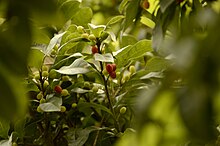Myrica
| Myrica | ||||||||||||
|---|---|---|---|---|---|---|---|---|---|---|---|---|

Gagel tree ( Myrica faya ) |
||||||||||||
| Systematics | ||||||||||||
|
||||||||||||
| Scientific name | ||||||||||||
| Myrica | ||||||||||||
| L. |
Myrica is a plant genus in the family of myricaceae (Myricaceae). The approximately 50 species are distributed almost worldwide; only in Australia and some warm-temperate areas of the Old World are no species.
description
Vegetative characteristics
The Myrica species are evergreen or deciduous trees or shrubs . There are resinous, shield-shaped glands on young parts of the plant. The leaves are simple and often clustered at the branch ends. The leaf margin is whole or serrated.

Generative characteristics
The Myrica species are dioecious ( dioecious ) or monoecious ( monoecious ) separate sexes. The flowering time is before or during the leaves shoot. The inflorescence is eternal, simple or panicle-like. In the flowers, the perianth is often reduced or completely absent. There may be cover sheets . Male flowers usually contain two to eight, rarely up to 20 stamens . The stamens are free or fused at the base, prophylls are present or absent. The female flowers contain two to four bracts. Two fruit leaves are a mostly single-chamber ovary grown. The ovary has resinous glands. The overgrown or free pens are short and have a relatively long scar and limp way branching scar on.
The stone fruits are often covered with head-like, wax-covered papillae. The endocarp is hard. The seeds are erect, their shell is membrane-like.
Systematics
The genus Myrica was established in 1753 by Carl von Linné in Species Plantarum , 2, p. 1024.
The genus Myrica includes around 50 species (selection):
- Myrica adenophora Hance : It thrives in forests and valleys in Taiwan only in Hengchun and in the Chinese provinces of Guangdong and Guangxi .
- Myrica californica Cham. (Syn .: Morella californica (Cham.) Wilbur ): It occurs in the US states of Oregon , Washington and California .
- Myrica cerifera L. (Syn .: Morella cerifera (L.) Small ): It occurs in the United States, Guatemala , Honduras , Belize , El Salvador , Nicaragua , Costa Rica , Panama and on the Caribbean islands.
- Myrica esculenta Buch.-Ham. ex D.Don (Syn .: Morella esculenta (Buch.-Ham. ex D.Don) IMTurner ): It occurs in India , Bhutan , Nepal , Thailand , Vietnam , China and Myanmar .
- Gagel tree ( Myrica faya Aiton )
- Gale shrub ( Myrica gale L. )
- Myrica hartwegii S. Watson
- Myrica heterophylla Raf. (Syn .: Morella caroliniensis (Mill.) Small ): It occurs in the eastern United States and in Texas .
- Myrica inodora W.Bartram (Syn .: Morella inodora (W.Bartram) Small ): It occurs in the US states of Alabama , Mississippi , Georgia , Louisiana and Florida .
- Myrica nana A. Chev. (Syn .: Morella nana (A.Chev.) J.Herb. ): It thrives at altitudes of 1900 to 3000 meters only in western Guizhou and in central and northern Yunnan .
- Myrica pensylvanica Mirb. (Syn .: Morella pensylvanica (Mirb.) Kartesz ): It occurs in eastern Canada and in the eastern United States.
- Myrica rubra Siebold et Zucc. (Syn .: Morella rubra Lour. ): It occurs in southern Korea , China, Taiwan , Japan and the Philippines .
Since 2005, some botanists have divided the genus Myrica sl into two genera based on the structure of the catkins and fruits: In the genus Myrica s. st. Only a few species remain and most of the species fall into the genus Morella Lour. posed.
literature
- Anmin Lu, Allan J. Bornstein: Myricaceae. : In: Wu Zheng-yi, Peter H. Raven (Eds.): Flora of China , Volume 4 - Cycadaceae through Fagaceae , Science Press and Missouri Botanical Garden Press, Beijing and St. Louis, 1999, ISBN 0-915279-70 -3 . Myrica Linnaeus , pp. 275-276 - online with the same text as the printed work .
Individual evidence
- ↑ a b c Anmin Lu, Allan J. Bornstein: Myricaceae. : In: Wu Zheng-yi, Peter H. Raven (Eds.): Flora of China , Volume 4 - Cycadaceae through Fagaceae , Science Press and Missouri Botanical Garden Press, Beijing and St. Louis, 1999, ISBN 0-915279-70 -3 . Myrica Linnaeus , pp. 275-276 - online with the same text as the printed work .
- ↑ a b c d e f g Myrica in the Germplasm Resources Information Network (GRIN), USDA , ARS , National Genetic Resources Program. National Germplasm Resources Laboratory, Beltsville, Maryland. Retrieved May 6, 2017.
- ↑ Valérie Huguet, Manolo Gouy, Philippe Normand, Jeff F. Zimpfer, Maria P. Fernandez: Molecular phylogeny of Myricaceae: a reexamination of host-symbiont specificity. In: Molecular Phylogenetics and Evolution , Volume 34, Issue 3, 2005, pp. 557-568. doi : 10.1016 / j.ympev.2004.11.018
- ^ J. Herbert: New combinations and a new species in Morella (Myricaceae). In: Novon , 2005, pp. 293-295.
- ↑ Rosalina Berazaín Iturralde, Banessa Falcón Hidalgo: Two new combinations in Morella (Myricaceae) for species of the Cuban Flora. In: Willdenowia , Volume 41, Issue 1, 2011, S, 113-114.
- ↑ Chipem Vashi, Uma Shankar, Arvind K. Misra: A reinstatement and a new combination in Morella subgenus Morella (Myricaceae), with typification of Myrica integrifolia. In: Phytotaxa , Volume 299, Issue 2, March 21, 2017. doi : 10.11646 / phytotaxa.299.2.5
